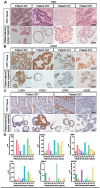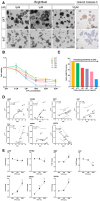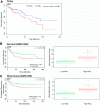Patient-Derived Colorectal Cancer Organoids Upregulate Revival Stem Cell Marker Genes following Chemotherapeutic Treatment
- PMID: 31906589
- PMCID: PMC7019342
- DOI: 10.3390/jcm9010128
Patient-Derived Colorectal Cancer Organoids Upregulate Revival Stem Cell Marker Genes following Chemotherapeutic Treatment
Abstract
Colorectal cancer stem cells have been proposed to drive disease progression, tumour recurrence and chemoresistance. However, studies ablating leucine rich repeat containing G protein-coupled receptor 5 (LGR5)-positive stem cells have shown that they are rapidly replenished in primary tumours. Following injury in normal tissue, LGR5+ stem cells are replaced by a newly defined, transient population of revival stem cells. We investigated whether markers of the revival stem cell population are present in colorectal tumours and how this signature relates to chemoresistance. We examined the expression of different stem cell markers in a cohort of patient-derived colorectal cancer organoids and correlated expression with sensitivity to 5-fluorouracil (5-FU) treatment. Our findings revealed that there was inter-tumour variability in the expression of stem cell markers. Clusterin (CLU), a marker of the revival stem cell population, was significantly enriched following 5-FU treatment and expression correlated with the level of drug resistance. Patient outcome data revealed that CLU expression is associated with both lower patient survival and an increase in disease recurrence. This suggests that CLU is a marker of drug resistance and may identify cells that drive colorectal cancer progression.
Keywords: bowel cancer; chemotherapy resistance; colon; colorectal; organoid; stem cell; tumoroid.
Conflict of interest statement
The authors declare no conflict of interest.
Figures



Similar articles
-
Clusterin: a marker and mediator of chemoresistance in colorectal cancer.Cancer Metastasis Rev. 2024 Mar;43(1):379-391. doi: 10.1007/s10555-024-10173-y. Epub 2024 Feb 6. Cancer Metastasis Rev. 2024. PMID: 38319453 Free PMC article. Review.
-
TRIB3 Interacts With β-Catenin and TCF4 to Increase Stem Cell Features of Colorectal Cancer Stem Cells and Tumorigenesis.Gastroenterology. 2019 Feb;156(3):708-721.e15. doi: 10.1053/j.gastro.2018.10.031. Epub 2018 Oct 24. Gastroenterology. 2019. PMID: 30365932
-
Hedgehog Signals Mediate Anti-Cancer Drug Resistance in Three-Dimensional Primary Colorectal Cancer Organoid Culture.Int J Mol Sci. 2018 Apr 6;19(4):1098. doi: 10.3390/ijms19041098. Int J Mol Sci. 2018. PMID: 29642386 Free PMC article.
-
Lgr5 promotes cancer stemness and confers chemoresistance through ABCB1 in colorectal cancer.Biomed Pharmacother. 2013 Oct;67(8):791-9. doi: 10.1016/j.biopha.2013.08.001. Epub 2013 Aug 23. Biomed Pharmacother. 2013. PMID: 24138824
-
Petosemtamab, a Bispecific Antibody Targeting Epidermal Growth Factor Receptor (EGFR) and Leucine-Rich G Repeat-Containing Protein-Coupled Receptor (LGR5) Designed for Broad Clinical Applications.Cancers (Basel). 2025 May 14;17(10):1665. doi: 10.3390/cancers17101665. Cancers (Basel). 2025. PMID: 40427162 Free PMC article. Review.
Cited by
-
Comparative Analysis of Patient-Matched PDOs Revealed a Reduction in OLFM4-Associated Clusters in Metastatic Lesions in Colorectal Cancer.Stem Cell Reports. 2021 Apr 13;16(4):954-967. doi: 10.1016/j.stemcr.2021.02.012. Epub 2021 Mar 11. Stem Cell Reports. 2021. PMID: 33711267 Free PMC article.
-
Organoid Models of Colorectal Pathology: Do They Hold the Key to Personalized Medicine? A Systematic Review.Dis Colon Rectum. 2020 Nov;63(11):1559-1569. doi: 10.1097/DCR.0000000000001806. Dis Colon Rectum. 2020. PMID: 32868555 Free PMC article.
-
Patient-Derived Tumor Organoids for Drug Repositioning in Cancer Care: A Promising Approach in the Era of Tailored Treatment.Cancers (Basel). 2020 Dec 4;12(12):3636. doi: 10.3390/cancers12123636. Cancers (Basel). 2020. PMID: 33291603 Free PMC article. Review.
-
Modeling colorectal cancer: A bio-resource of 50 patient-derived organoid lines.J Gastroenterol Hepatol. 2022 May;37(5):898-907. doi: 10.1111/jgh.15818. Epub 2022 Mar 10. J Gastroenterol Hepatol. 2022. PMID: 35244298 Free PMC article.
-
Current strategies with implementation of three-dimensional cell culture: the challenge of quantification.Interface Focus. 2022 Aug 12;12(5):20220019. doi: 10.1098/rsfs.2022.0019. eCollection 2022 Oct 6. Interface Focus. 2022. PMID: 35992772 Free PMC article. Review.
References
Grants and funding
LinkOut - more resources
Full Text Sources
Research Materials
Miscellaneous

